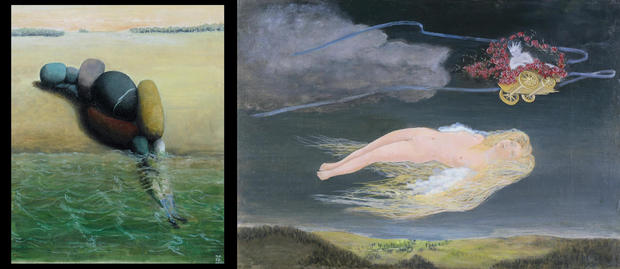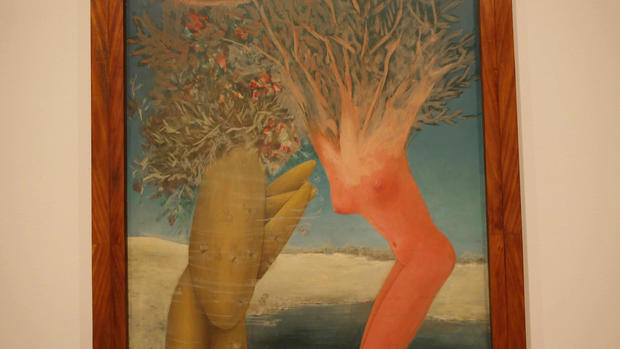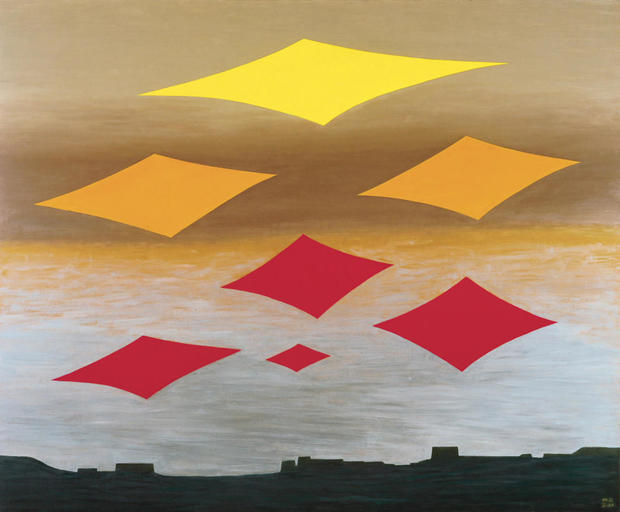Meret Oppenheim: An artist beyond categorization
Her work spans over half a century of artistic styles, from the abstract to the surreal. But Meret Oppenheim was an artist who defies labels.
Anne Umland, curator of the Meret Oppenheim retrospective now on view at the Museum of Modern Art in New York City, said, "Meret Oppenheim is one of the great modern artists. She's fiercely original, and she's very hard to pigeonhole."
Altschul asked, "How would you define Meret Oppenheim if she doesn't want to be defined?"
"It makes it very difficult!" she laughed. "There isn't a one-liner for Meret Oppenheim."
Born in Germany in 1913 to a German-Jewish father and Swiss mother, Oppenheim and her siblings spent much of their lives in Switzerland. Her grandmother, Lisa Wenger, was a beloved children's book author and illustrator, and Oppenheim's first artistic influence.
Oppenheim's niece, also named Lisa Wenger, has chronicled her aunt's life in two publications, including an expanded English translation of "Meret Oppenheim: My Album."
Wenger said Oppenheim's family supported her love of magic and fairy tales, "because her grandfather, my great-grandfather, used to read to them every night some stories." And so, as a young girl, she began to draw and paint.
She left school and moved to Paris at the age of 18, with the dream of becoming an artist. There, she frequented the haunts of painters and sculptors, like Alberto Giacometti and Hans Arp. Umland said, "They're the first people to see her work in fact, and to encourage her to exhibit with these artists and poets known as the surrealists."
Two years later, Oppenheim joined an exhibit of these surrealists, propelling herself onto the Paris art scene.
"She always would say later in life the surrealists were her first audience – they were the ones who took her seriously," Umland said.
Then, it happened. In 1936, Oppenheim created a piece that threatened to define her. It all started with a fur bracelet she made and wore to breakfast with Pablo Picasso and his girlfriend, artist Dora Maar, when Oppenheim was just 22 years old.
"Either Dora Maar or Picasso looks over at her bracelet and says, 'Oh, you can cover anything with fur these days,'" Umland said. "And then Meret Oppenheim looks down at her cup and says, 'Even this teacup.'"
The art world was both appalled and amazed by "The Object" (as Oppenheim called it), and it was quickly snatched it up by MoMA, where it remains today in their permanent collection.
"People came to take this so seriously, but it began as a joke," Umland said.
Altschul said, "I can't even imagine what her friends and colleagues and the art folks were saying to her: You know, you've gotta cover everything in fur, just put fur on it! And she said no?"
"She said no! She said, 'I am not going to be known as the artist who covers things in fur.'"
While her career was on the rise, so was the war in Europe, and Oppenheim was forced to return to Switzerland. This began what she called her "crisis period," which lasted from 1937 to 1954.
Wenger said, "Seventeen years! In fact, in 1937 she writes that she never even touched a pen or anything, she didn't do anything."
Oppenheim felt her work lacked substance during this time, but this retrospective shows a return to her roots of fantasy and fairy tales. "We can almost feel her grandmother's presence, just with the stories," said Altschul.
One painting is titled "Daphne and Apollo." "You know that she had that Greco-Roman myth in mind, but as usual she gives it her own particular spin," Umland said.
According to Oppenheim, one day she woke up from her "crisis," and went into full creative mode again, until she died of a heart attack in 1985.
"I think certainly Meret Oppenheim is lucky in the sense that she did make it into the history books," said Umland. "And she lived to age 72. I find it very moving how steadfast she was in always wanting to reinvent herself. You can walk through the show and see countless different ideas on the wall, but it's all her."
For more info:
- Meret Oppenheim: My Exhibition, at the Museum of Modern Art, New York (through March 4)
- Exhibition catalogue: "Meret Oppenheim: My Exhibition," edited by Nina Zimmer, Natalie Dupêcher, Anne Umland, with Lee Colón and Nora Lohner (MoMA), in Hardcover format, available via Amazon, Barnes & Noble, and Indiebound
- "Meret Oppenheim: My Album," edited by Lisa Wenger and Martina Corgnati (Scheidegger and Spiess), in Trade Paperback, available via Amazon, Barnes & Noble, and Indiebound
- All works by Meret Oppenheim © 2023 Artists Rights Society (ARS), New York / ProLitteris, Zurich
- Photos courtesy of Nanda LanFranco, and Keystone SDA/Kurt Blum
- Family photos provided by Lisa Wenger
Story produced by Amy Wall. Editor: Lauren Barnello.
See also:
- War and the art of surrealism ("Sunday Morning")
- "Women's Work": Art from the hands of women who persisted ("Sunday Morning")
- Recreating Matisse's "The Red Studio" ("Sunday Morning")
- The artist as searcher: Cézanne works on paper ("Sunday Morning")
- The restless perfectionism of Alberto Giacometti ("Sunday Morning")
- Picasso and his mistress, his muse ("Sunday Morning")
- The long shadow of Claude Monet ("Sunday Morning")
- Helen Frankenthaler: An artist lost in the moment ("Sunday Morning")
- Georgia O'Keeffe and her visions of Hawaii ("Sunday Morning")
- Frida Kahlo: The unapologetic artist ("Sunday Morning")
- Seurat and "La Grande Jatte" ("Sunday Morning")
- "Van Gogh in America": How the Dutch artist entranced a nation ("Sunday Morning")
- Artist Pierre Soulages, "The Master of Black" ("Sunday Morning")
- The tragedy of avant garde artist Ernst Kirchner ("Sunday Morning")
- Almanac: The 1913 Armory Show ("Sunday Morning")
- Enjoying armchair tours of museums ("Sunday Morning")









